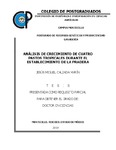| dc.contributor.author | Calzada Marín, Jesús Miguel | |
| dc.creator | CALZADA MARÍN, JESÚS MIGUEL; 371993 | |
| dc.date.accessioned | 2019-05-22T17:19:39Z | |
| dc.date.available | 2019-05-22T17:19:39Z | |
| dc.date.issued | 2019-01 | |
| dc.identifier.uri | http://hdl.handle.net/10521/3223 | |
| dc.description | Tesis (Doctorado en Ciencias, especialista en Ganadería).- Colegio de Postgraduados, 2019. | es_MX |
| dc.description.abstract | El objetivo de este experimento fue realizar un análisis de crecimiento de los pastos Taiwan (Pennisetum purpureum), Chetumal (Brachiaria humidicola CIAT 679), Toledo (Brachiaria brizantha CIAT 26110) y Cayman (Brachiaria híbrida CIAT BR02/1752) desde la siembra hasta los 180 días después de la siembra, para encontrar el momento óptimo para el primer aprovechamiento. Se evaluó la composición morfológica (CM), tasa de crecimiento (TC), altura, radiación interceptada (RI), relación hoja/tallo (H:T), hoja/no hoja (H:NH) y biomasa aérea; a intervalos de quince días, a excepción de los dos primeros muestreos que fueron cada 30 días. Los datos se analizaron mediante el procedimiento GLM de SAS, bajo un diseño experimental de bloques al azar, con medidas repetidas en el tiempo, con tres repeticiones. La CM de los pastos fue estadísticamente diferente (P<0.05) a las diferentes edades de crecimiento. La máxima acumulación de biomasa total y TC se alcanzó a los 135 dds para los pastos Taiwan y Chetumal; a esta edad las praderas tenían una altura de 2.49 m y 0.68 m respectivamente, así como una RI de 92% y 100%. Para los casos de Toledo y Cayman la mayor biomasa total y TC se alcanzó a los 150 dds con una altura de 1.06 y 0.86 m respectivamente y 100% de RI en ambos casos. La relación H:T y H:NH en todos los casos disminuyeron con el incremento en la edad de las plantas. Para cada uno de los forrajes, se sugiere realizar el primer aprovechamiento cuando la mayor acumulación de biomasa total y TC coinciden. _______________ GROWTH ANALYSIS OF FOUR TROPICAL GRASS DURING THE ESTABLISHMENT OF MEADOW. ABSTRACT: The objective of this experiment was to perform a growth analysis of the Taiwan (Pennisetum purpureum), Chetumal (Brachiaria humidicola CIAT 679), Toledo (Brachiaria brizantha CIAT 26110) and Cayman (Brachiaria hybrid CIAT BR02 / 1752) pastures from sowing to 180 days after sowing, to find the optimum moment for the first harvest. The morphological composition (CM), growth rate (TC), height, intercepted radiation (RI), leaf / stem ratio (H: T), leaf / non-leaf (H: NH) and aerial biomass were evaluated; at intervals of fifteen days, except for the first two samples that were every 30 days. The data were analyzed using the SAS GLM procedure, under an experimental design of randomized blocks, with measures repeated over time, with three repetitions. The CM of the pastures was statistically different (P <0.05) at the different growth ages. The maximum accumulation of total biomass and TC was reached at 135 dds for the Taiwan and Chetumal pastures; at this age the grasslands had a height of 2.49 m and 0.68 m respectively, as well as an RI of 92% and 100%. For the cases of Toledo and Cayman the highest total biomass and TC was reached at 150 dds with a height of 1.06 and 0.86 m respectively and 100% of IR in both cases. The ratio H: T and H: NH in all cases decreased with the increase in the age of the plants. For each of the forages, it is suggested to make the first use when the greatest accumulation of total biomass and TC they match. | es_MX |
| dc.description.sponsorship | Consejo Nacional de Ciencia y Tecnología (CONACyT). | es_MX |
| dc.format | pdf | es_MX |
| dc.language.iso | spa | es_MX |
| dc.rights.uri | http://creativecommons.org/licenses/by-nc-nd/4.0 | es_MX |
| dc.subject | Pennisetum | es_MX |
| dc.subject | Brachiaria | es_MX |
| dc.subject | Crecimiento | es_MX |
| dc.subject | Biomasa | es_MX |
| dc.subject | Aprovechamiento | es_MX |
| dc.subject | Radiación interceptada | es_MX |
| dc.subject | Growth | es_MX |
| dc.subject | Biomass | es_MX |
| dc.subject | Harvesting | es_MX |
| dc.subject | Intercepted radiation | es_MX |
| dc.subject | Ganadería | es_MX |
| dc.subject | Doctorado | es_MX |
| dc.subject.classification | CIENCIAS AGROPECUARIAS Y BIOTECNOLOGÍA::CIENCIAS AGRARIAS::AGRONOMÍA::PASTOS | es_MX |
| dc.title | Análisis de crecimiento de cuatro pastos tropicales durante el establecimiento de la pradera. | es_MX |
| dc.type | Tesis | es_MX |
| Tesis.contributor.advisor | Ortega Jiménez, Eusebio | |
| Tesis.contributor.advisor | Enriquez Quiroz, Javier Francisco | |
| Tesis.contributor.advisor | Mendoza Pedroza, Sergio Iban | |
| Tesis.contributor.advisor | Vaquera Huerta, Humberto | |
| Tesis.contributor.advisor | Escalante Estrada, José Alberto | |
| Tesis.contributor.advisor | Honorato Salazar, José Amador | |
| Tesis.date.submitted | 2019 | |
| Tesis.date.accesioned | 2019 | |
| Tesis.date.available | 2019 | |
| Tesis.format.mimetype | pdf | es_MX |
| Tesis.format.extent | 961 KB | es_MX |
| Tesis.subject.nal | Cenchrus purpureus | es_MX |
| Tesis.subject.nal | Urochloa humidicola | es_MX |
| Tesis.subject.nal | Urochloa brizantha | es_MX |
| Tesis.subject.nal | Valor nutritivo | es_MX |
| Tesis.subject.nal | Nutritive value | es_MX |
| Tesis.subject.nal | Composición química | es_MX |
| Tesis.subject.nal | Chemical composition | es_MX |
| Tesis.subject.nal | Defoliación | es_MX |
| Tesis.subject.nal | Defoliation | es_MX |
| Tesis.subject.nal | Municipio de Isla, Veracruz, México | es_MX |
| Tesis.rights | Acceso abierto | es_MX |
| Articulos.subject.classification | Plantas forrajeras | es_MX |
| dc.type.conacyt | doctoralThesis | es_MX |
| dc.identificator | 6||31||3103||310310 | es_MX |
| dc.contributor.director | ORTEGA JIMÉNEZ, EUSEBIO; 120325 | |
| dc.audience | generalPublic | es_MX |


